
March, 1958 Vol. 4, No. 1
Managing Editor P. V. Vygantas
 |
www.lituanus.org |
| Copyright
© 1958 Lithuanian
Students Association, Inc. March, 1958 Vol. 4, No. 1 Managing Editor P. V. Vygantas |
|
THE ARTIST M. V. DOBUJINSKY
M. VOROBIOVAS
Dr.
Mikalojus Vorobiovas, bom in 1903 in Điauliai, Lithuania, studied art
history, classical archeology, philosophy and Slavistics at the
universities of Marbourg, Berlin and Munich and taught art history at
Kaunas and Vilnius, Lithuania, and Smith College, Mass. He was the
author of several books and had contributed to Lithuanian and German
periodicals.
This article originally appeared in Lithuanian in the cultural magazine "Aidai." Both the author and the artist have died since: Dr. M. Vorobiovas in June of 1.954,' M. V. Dobujinsky in November of 1957.
M. V. Dobujinsky's inexhaustible creative energy was not only a source
of new ideas but also astounds us with its almost springlike freshness.
This is a rare attribute, considering the dreary and spiritless
attitude of modern artists.
The youthful energy of his works appears even more astounding if we bear in mind the distance that separates his works from the uneasy experimentation of the past several decades. His only aim was the search for perfection along the road he chose almost half a century ago.
While Dobujinsky responded sensitively to the changing trends in 20th century art, he never attempted to become a cubist or a surrealist. He remained steadfastly faithful to his own particular individuality as an artist — so much so that one of his vignettes or book-cover decorations or other works of 40 years ago remains as full of vivacious lyrical feeling and magical enchantment as if it were a work of the present day. And the viewer of such works no more considers the date of their creation than one would assign a Chopin prelude to a particular historic milieu.
M. V. Dobujinsky was born in 1875 in Novgorod, but — with the exception of several schoolboy years spent in Vilnius — he spent the greater part of his life up to 1924 in St. Petersburg. His mother was an opera singer; his father was a general in the artillery, a highly educated and cultured man who traced his ancestry back to the Lithuanian nobility of the Middle Ages.
Dobujinsky displayed a passion for drawing from his early childhood, and under his father's guidance he did a great deal of drawing, mostly from nature. He attended art classes even before he entered secondary school, and he continued his art studies at Vilnius High School and the University of St. Petersburg, from which he graduated as a candidate in law. Along with his nature studies, the best school for the young artist was furnished by the old masters, and he studied them assiduously in St. Petersburg's Hermitage and in foreign galleries — Dresden, Munich, Berlin. He made his first trip to Germany and Switzerland while he was still a student, and afterwards he made annual trips to Western Europe, studying its scenery and ancient monuments and always returning home with many new landscapes.
After Dobujinsky completed his university studies, in 1899, he studied painting for two years in Munich, under the noted art teacher A. Azbe, and spent his summers in Hungary taking advanced lessons from the painter Hollosy. Later, feeling especially attracted toward painting and the graphic arts, he studied the ofort technique under Professor Mathey, a well-known authority who taught at the St. Petersburg Academy.
In 1902, Dobujinsky established close ties with the "World of Art" group of artists in St. Petersburg, which was led by S. Diaghilev and A. Benois. He showed his works at their exhibitions and contributed graphic art to their journal. This association immediately helped Dobujinsky to find his own creative bent and to develop further his own style, to which he was faithful all his life.
The activities of the "World of Art" group governed a whole epoch in the evolution of modern Russian art. The artist members of the group were extreme individualist-esthetes. Their aim was to raise the level of esthetic culture and to revive the principles of pure art. They had to struggle against the fossilized routine of the Academy and even more against the "common man" tendency that had become prominent in painting around 1860. A prominent school of late-19th-century artists was concerned solely with the idea content in art; they looked with scorn on matters of technique, style and artistic ability, and their paintings more and more tended to become nothing but crude illustrative realism. This esthetically reactionary trend has totally overwhelmed Soviet Russia in our times, in the form of "socialist realism."
The "World of Art" determined to return beauty to art; this could be attained only through the deliberate cultivation of form, through improved color and composition, through increased sensitivity. In general, the members of the group sought for the highest quality in their works. These artists studied the old and new masters of Western Europe and the great Russian masters of the 18th and 19th centuries. Enthralled by the beauty of bygone ages, they were fully conscious of the artistic values of the Middle Ages, of the ancient world and of Eastern art, and they were captivated by the grandeur of old Russian architecture, especially the baroque and empire styles that blossomed in the residences of the nobility in St. Petersburg.
Thus we come to understand the retrospective nature of the "World of Art," its romantic love of the past, its subtle and thorough comprehension of earlier styles. All this has close connections with the artistic thought of M. Dobujinsky.
Dobujinsky is an artist of very wide range, in terms of both technique and genre. Various techniques alternate in his paintings: oil, water color, gouache and pastel. As a graphic artist he handled pen, pencil and ofort with equal virtuosity and had an especial affinity for the lithograph.
We find the same variety in genre. As a land-scapist, Dobujinsky was most interested in architectural portraiture — old towns and cities, or individual monuments. His taste having been developed within sight of St. Petersburg's grand and lovely architecture, he painted "portraits" of European capitals and of the quiet countryside with great feeling. He sketched and painted landscapes in England, France, Italy, Belgium, Holland and Denmark, as well as of Russian cities. The landscapes he painted in Lithuania, Latvia and Estonia are especially fascinating. His range within this branch of art was extremely wide; he was enchanted as much by idyllic, peaceful scenery as by ancient and legendary buildings. He portrayed the poverty of slums and the shocking contrasts that can be seen in city streets as well as the grandiose city centers. Finally, after keen study of the modern Babylons, with their gigantic structures of steel, concrete and glass, he passed, in a series of lithographs, to dreams of future cities that are truly apocalyptic in their vision.
He also painted in the United States. Along with pictures of New York and Boston, he has painted a series of picturesque scenes of Newport that reveal the fading beauty of its old New England architecture.
It is quite natural that this subtle portraitist-lyricist of architectural ensembles should have become one of the most noted theatrical designers of our time. It is estimated that from 1907 Dobujinsky designed more than 80 stage settings (without mentioning the many costumes he also designed) for European and American ballet and for opera and drama theaters. In this connection must be mentioned his astonishingly beautiful stage designs for the Stanislavsky Art Theater in Moscow, which brought him immediate fame in this field, and also his designs for Diaghilev ballets in Paris and London productions. After the First World War, Lithuania and other European countries were delighted by his sets for the operas "Pique Dame" and "Eugene Onegin." After 1939, when he moved to New York, he designed some 15 sets for the Metropolitan and City Center opera houses and for other theaters in the United States and Canada. His stage designs were immediately striking for their extraordinary and imaginative evocation of "period." They so enchanted audiences by their harmonies of color and light that not infrequently they were greeted with tremendous ovations.
Closely connected with Dobujinsky's stage work were his "interiors" — plafonds, panels and murals v/ith which he decorated many residences and other buildings in Russia, Lithuania, Belgium and other countries.
Dobujinsky gained a vast reputation among the world's bibliophiles as an illustrator of books. The art of book illustration was revived in England in the 19th century (.William Morris, Aubrey Beardsley) and later in Germany; it especially flourished among the "World of Art" group, and Dobujinsky became a leading figure in the field. The works of Anderson, Pushkin, Dostoyevsky and other classical writers that he illustrated furnish great pleasure to the reader, all the more so in that the artist, in subtly re-creating the spirit and times of the author — on the cover, in the frontispiece or in vignettes — never encroaches upon the reader's imagination but satisfies himself with broad allusions, decorating the flat surface of the page with infinite tact and in complete harmony with the general nature of the book and with its type.
In 1923, Dobujinsky, then a professor at the St. Petersburg Academy, once more traveled to Western Europe, after a longer-than-usual interval, and there visited Germany, Denmark and Paris. The following year he left Russia for good; he stayed for a while in Riga, then went to Berlin, and later settled in Paris, where he was often invited to participate in exhibitions, decorate homes and design for the stage. In 1925 the Lithuanian State Opera produced "Pique Dame" with sets by Dobujinsky, and in the same year four exhibitions of his work were held In Kaunas and Klaipeda. Thus he established firm ties with independent Lithuania.
The decade 1929—1939, during which Dobu-jonsky resided in Kaunas, belongs to the most productive period of his career. He designed more than 30 theater sets in this time, most of them for the Lithuanian State Theater. He did the stage designs and costumes for P. Vaičiűnas' play "Aukso Gromata" ("The Golden Missive") and for plays by Shakespeare and Schiller; for the operas "Pique Dame," "Faust," "Prince Igor," "Tann-hauser," "Don Giovanni," "Radvila Perkűnas" and others; and for the ballets "Sleeping Beauty," "Raymonda" and "Coppelia." The ballets were also performed by the Kaunas Ballet on tours to Monte Carlo and London. It may be noted that Dobujins-ky's settings contributed greatly to the favorable reception of Lithuanian productions in Europe.
As we have seen, Dobujinsky's ties with Lithuania went back to his childhood and youth. It may be interetsing to note that later he — along with A. Benois and others of the "World fo Art" group — was among the first to recognize the genius of M. K. Čiurlionis. This group must be credited with supporting and encouraging Čiurlionis as an artist and arranging for the exhibition of his work in St. Petersburg and Moscow.
Having long been enamored of Lithuania's landscapes and ancient architecture, Dobujinsky, even before the First World War, often visited that country to paint. The Čiurlionis Gallery in Kaunas later acquired 29 of his gouaches of views of the old city of Vilnius. In 1933—1934 he covered most of Lithuania, revealing ever-new glimpses of her towns and countryside.
At the same time he actively participated, as member of commissions and as a critic, in the restoration of ancient buildings and monuments. Dobujinsky was facile with his pen, and he published a number of articles, among them "The National Flag," "A History of the Coat of Arms," "Ancient Lithuanian Maps," "The Reform of the School of Art" and "The Course of National Art."
Of his work in Lithuania, mention might be made of the many book and periodical illustrations and posters he did there, and also the interior decorations for the Presidential Palace, a niche in the Chapel of Vytautas the Great in the War Museum, the Jonas Vailokaitis residence and the Lithuanian Embassy in Berlin.
Dobujinsky taught art for several years in Lithuania before he began to devcte all of his time and talent to the Lithuanian State Theater. In 1929 and 1930 he taught at the Kaunas Art Institute and later, until 1933, he taught in his own studio. He had an undoubted influence on young Lithuanian painters. It would nevertheless appear that an artist with such a comprehensive viewpoint would exert more influence through the total body of his work and the vividness of his personality than he would exert were he limited to the role of teacher. Working in the broadest fields of pure and decorative art, he influenced others, with his creations and his pure taste, as a living example and created around himself a unique atmosphere that combined a high spirit of masterfulness, winged fantasy, sincere lyricism, inspiration and — what is most important — an aristocratic restraint, a feeling for harmony and moderation. This creates its own magical mood, to which surrender even those who look skeptically at "outdated" lyrical romanticism and its means of expression: the graceful silhouette, a playful but distinct and pure line, imposing ornamental ideas, etc. The younger Lithuanian artists, who in general find the greatest appeal in the "left" group of Parisian artists or in native folk art, with its primitive and vital colors, hold M. Dobujinsky in high regard.
Translated by
P. W. Urban
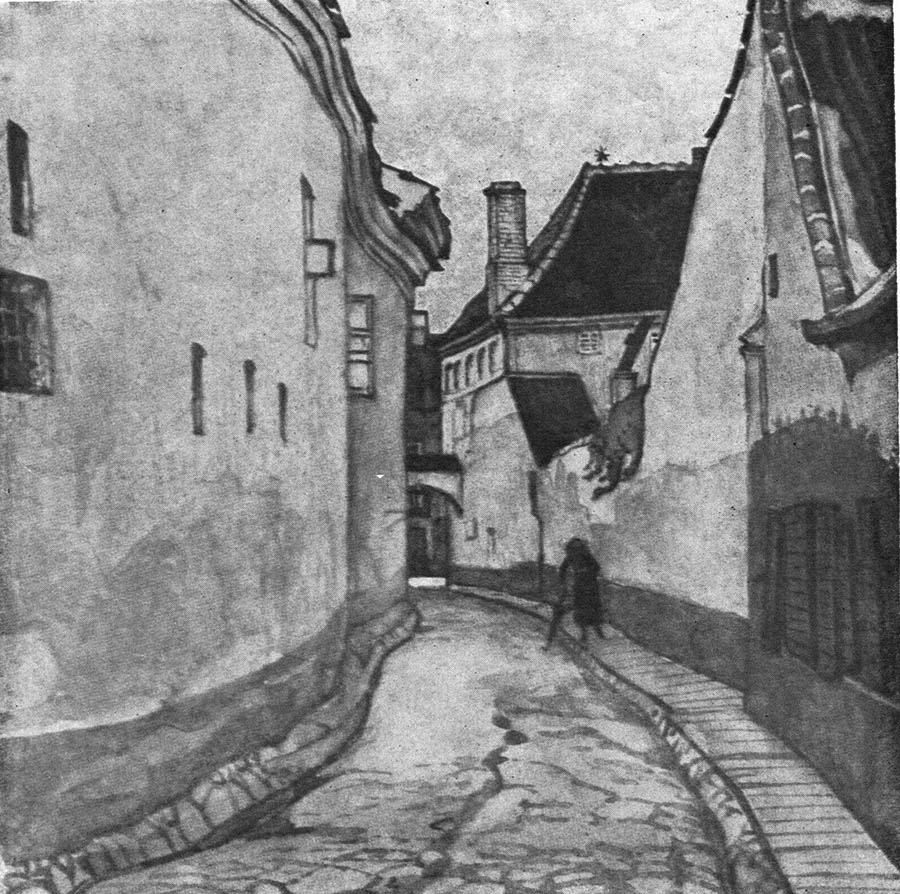
Street in Old Vilnius
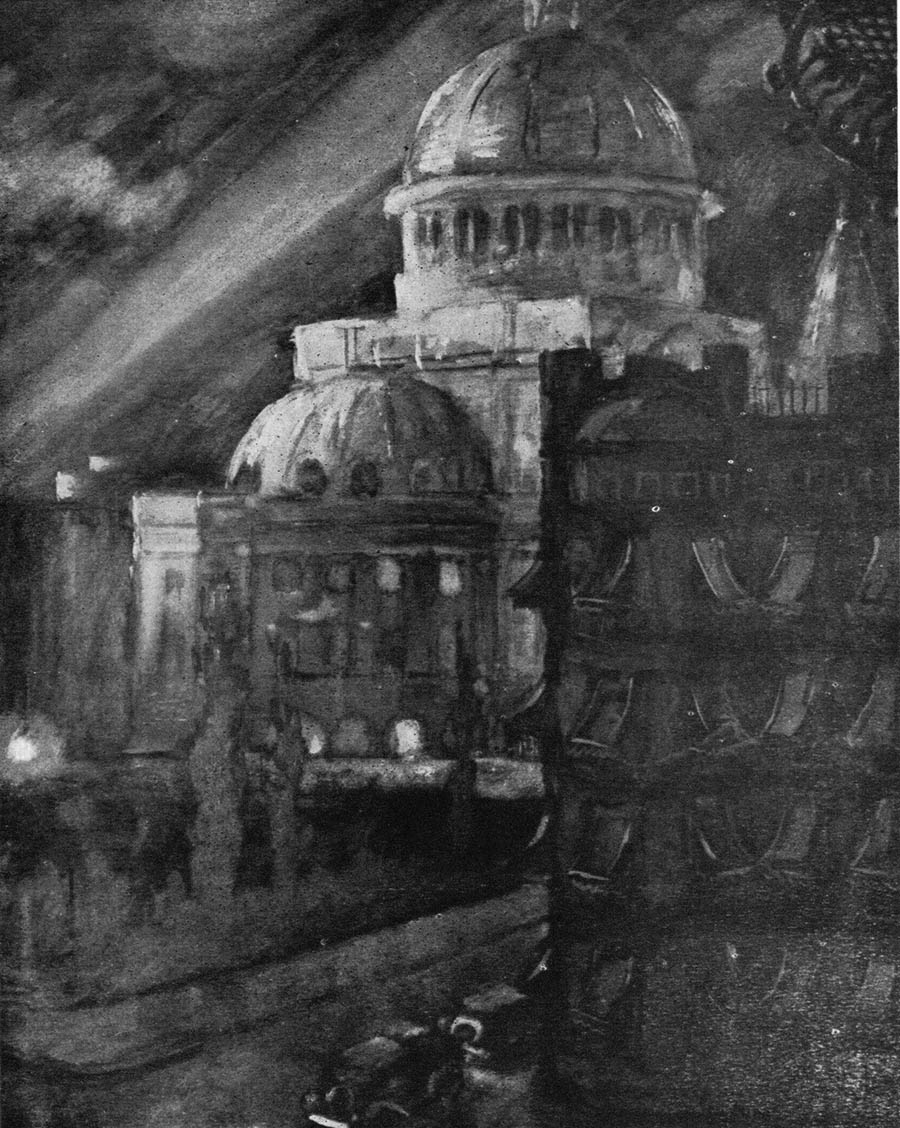
Boston at Night
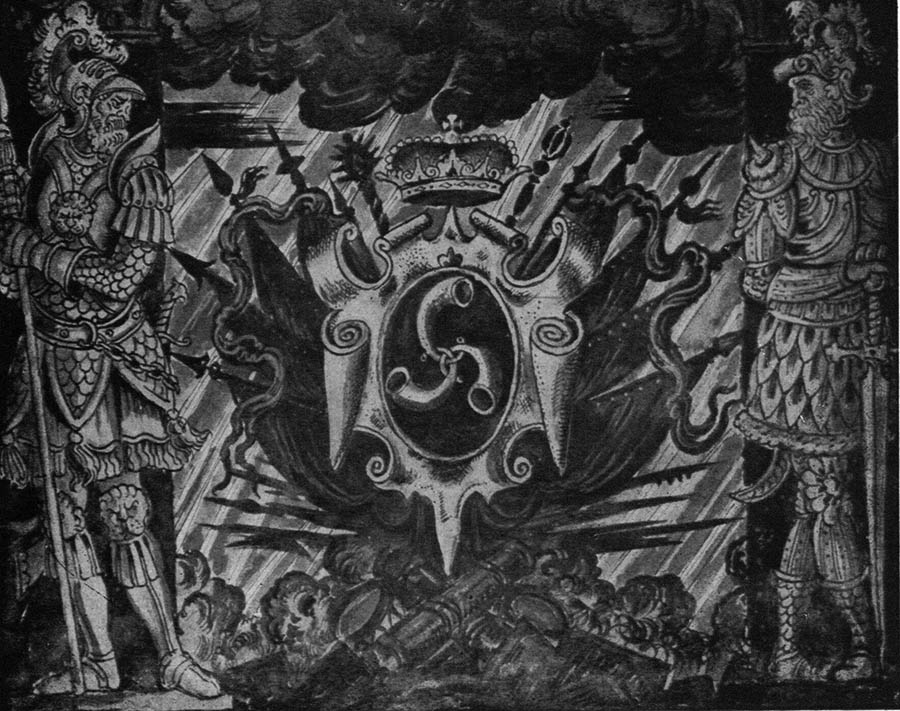
Curtain for the Opera
"Radvila Perkűnas"
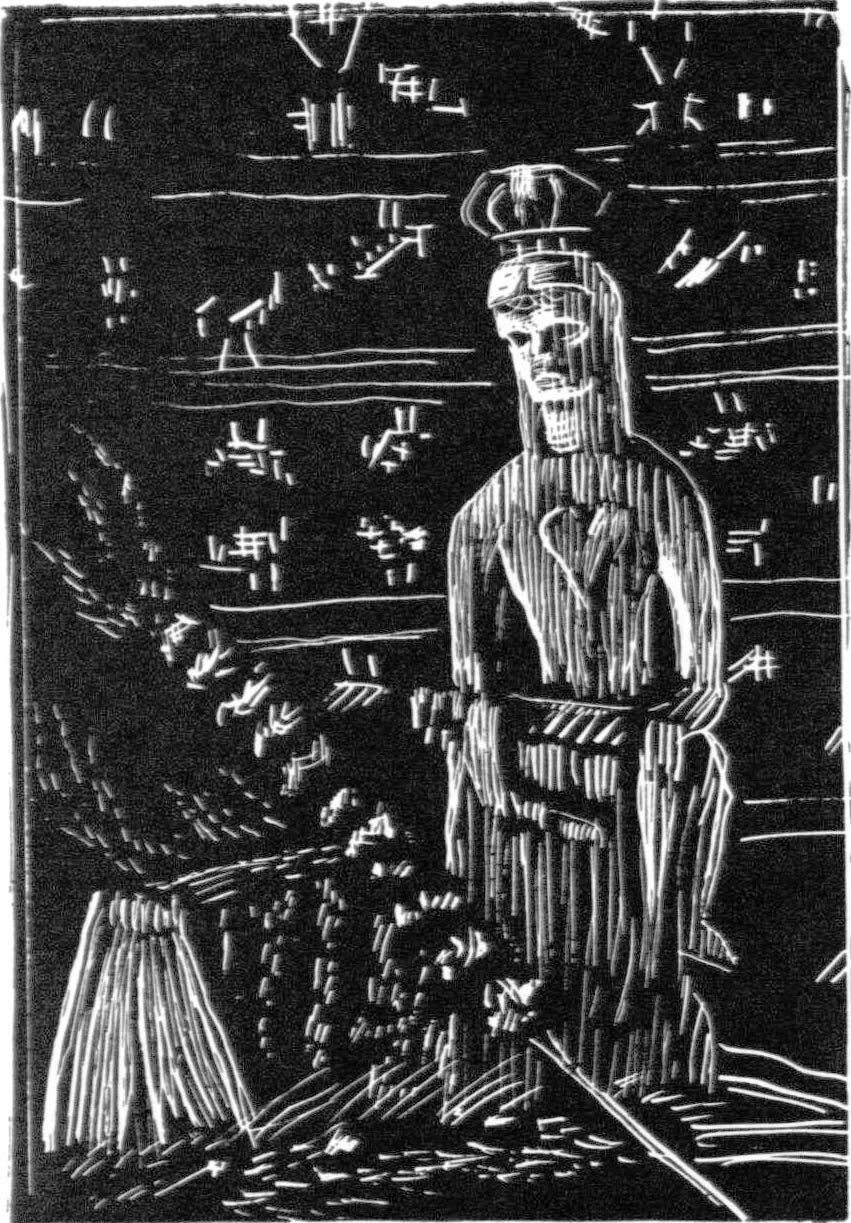
Madonna
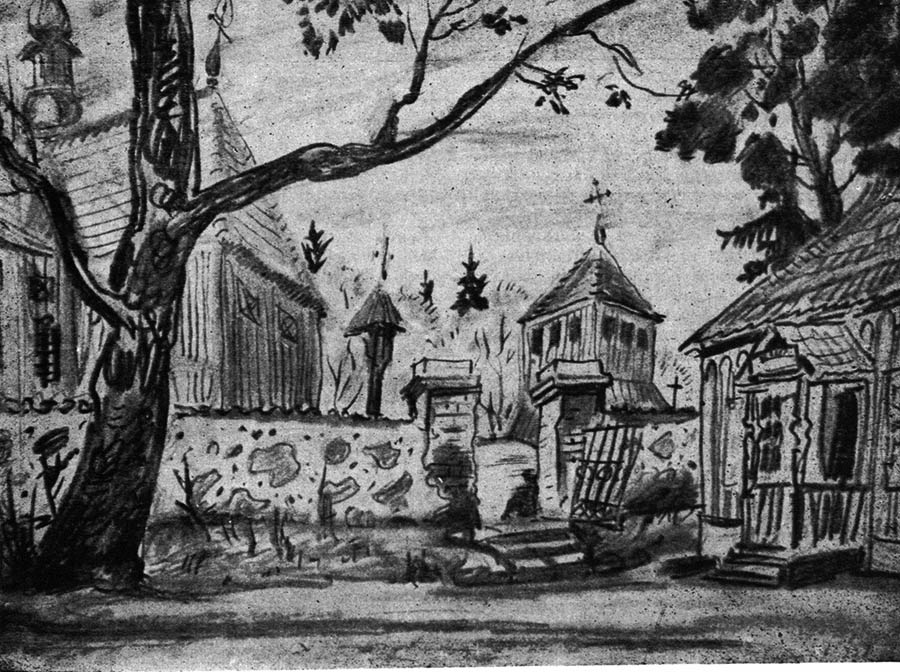
Stage set for play
"Aukso Gromata"
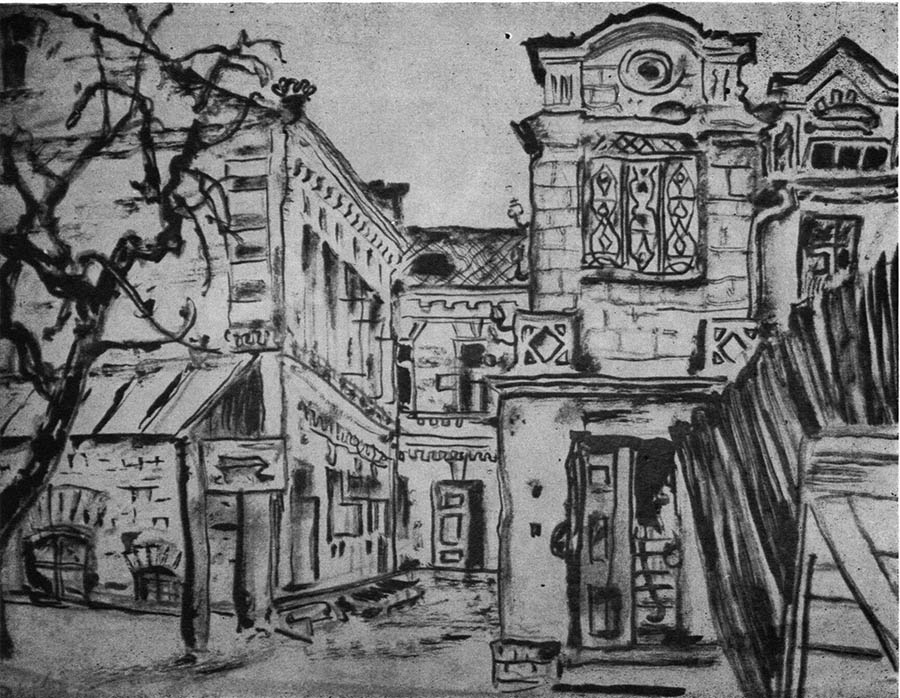
The Old city of Kaunas
Errata: An early 19th century primitive by an unkown artist
owned by Dobujinsky
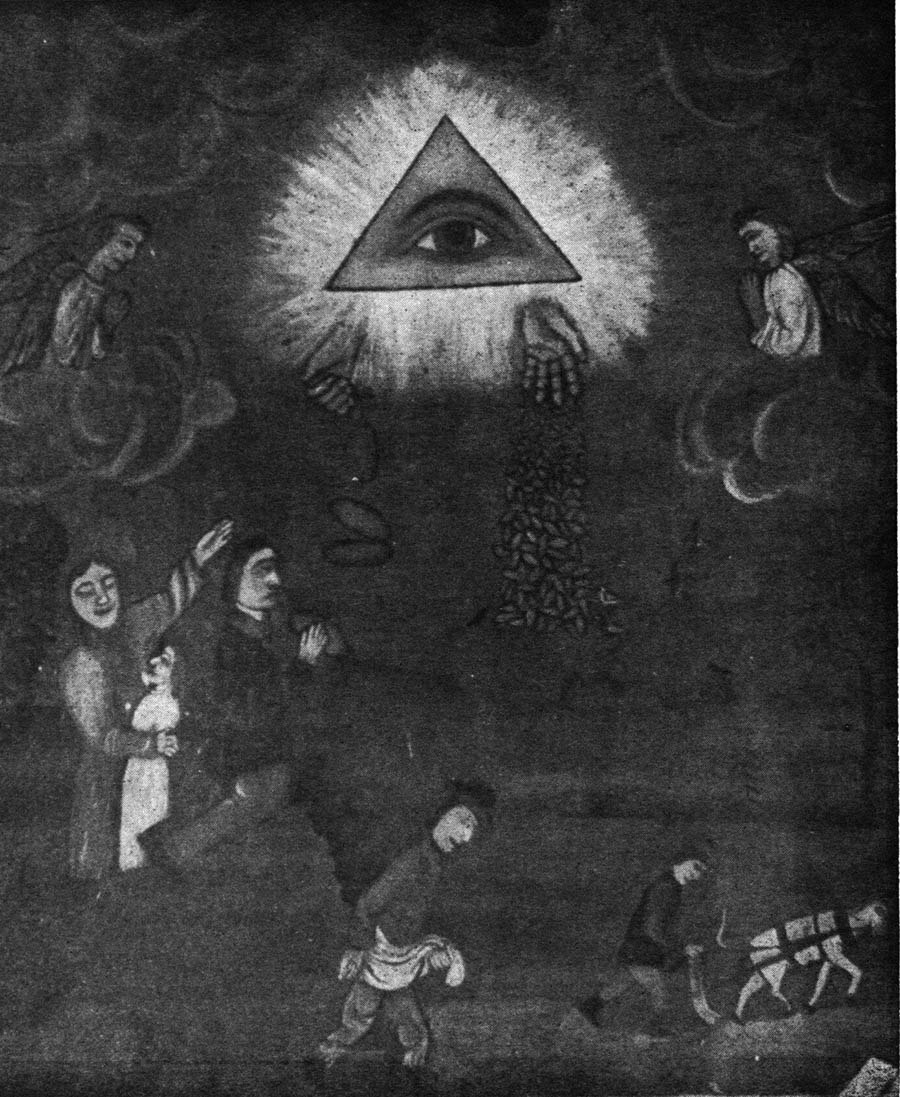
Providence